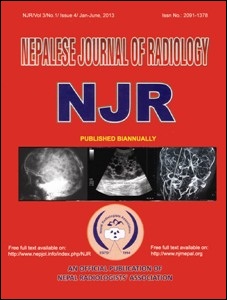Comparative Study of Sonourethrography and Radiographic Urethrogaphy in Urethral Lesions
DOI:
https://doi.org/10.3126/njr.v3i1.8714Keywords:
Micturating Cysto-Urethrography, Retrograde Urethrography, SonourethrographyAbstract
Background: The radiographic urethrography is an invasive , time consuming procedure and due to risk of radiation exposure can’t be repeated when required, further it has failed to demonstrate periurethral abnormality as a cause of urethral lesion. Where as sonourethrography is a noninvasive, painless, cheap, quick, easy to perform and without radiation exposure and provide detail visualization of mucosal and periurethral soft tissue.
Objectives: To establish the accuracy of sonourethrography in detecting urethral lesions.
Materials and Methods: Study was conducted as single blind prospective study to compare the radiographic urethrography (RGU/MCU) and sonourethragraphy and to established their role and accuracy in evaluation of urethral abnormalities. The findings and results of radiographic urethrography and sonourethrography were correlated and considering radiographic urethrography as gold standard, accuracy of sonourethrography in diagnosis of urethral lesions were analyzed.
Result: Total of 27 patients were included in the study. RGU showed normal anterior (penile and bulbar) urethra in 12 out of 27 cases while among these only 9 were normal on sonourethrography. The length of stricture measured on sonourethrography was slightly more than as measured on RGU. Periurethral causes for urethral abnormality were completely identified on sonourethrography while they were not identified on RGU.
Conclusion: Radiographic urethrography though gold standard in evaluating urethral abnormalities, sonourethrography is equally accurate (sensitivity 100%) in the diagnosis of urethral lesions. Sonourethrography has advantage in better evaluating mucosal and periurethral abnormalities as cause of urethral lesions. Further sonourethrography is more accurate in measurement of stricture length and it is cheap, safe and does not provide any kind of radiation to the patients in gonad areas.
Nepalese Journal of Radiology / Vol.3 / No.1 / Issue 4 / Jan-June, 2013 / 33-39
Downloads
Downloads
Published
How to Cite
Issue
Section
License
This license enables reusers to distribute, remix, adapt, and build upon the material in any medium or format, so long as attribution is given to the creator. The license allows for commercial use.




